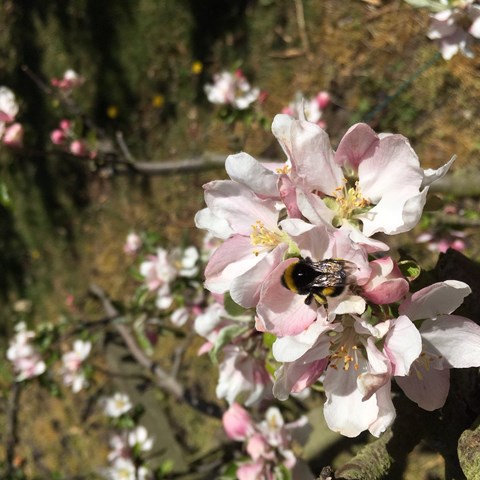Contact
Lotta Fabricius Kristiansen
Research assistent at Department of People and Society
Telephone: +4651167116, +46730577151

In this project, we are building utility parks at four apple orchards in Skåne, to counteract the challenges today's agricultural landscape poses for biodiversity and to create benefits in apple cultivation. From SLU RådNu, Lotta Fabricius Kristiansen participates. The project runs from 2021 to 2024 and is funded by Partnership Alnarp.
Apple is grown today in Sweden according to the principles of Integrated Pest Management (IPM), with a focus on preventing pest problems by monitoring to put in place more reactive measures when it is really needed.
A further development of the IPM principles, especially for insect pollinated crops such as apple, is IPPM (Integrated Pest and Pollinator Management), which takes pollination needs and pollinator health into account when choosing plant protection strategy and other cultivation measures. In both IPM and IPPM, there is a great need for ecological knowledge to know what measures affect utility animals, such as natural enemies of pests and pollinators of crops.
In order to translate such knowledge into applicable measures in commercial and recreational farming, evidence-based advice is needed. Horticulture is an area with relatively few advisors and little research, which means that the evidence base is limited.
In this project, we are building utility parks at four Scanian apple orchards, to counteract the challenges today's agricultural landscape poses for biodiversity and to create benefits in apple cultivation. The utility parks are designed with the potential to benefit utility animals in apple cultivation for increased crop yield, serve as a haven for biodiversity in used landscapes and be a meeting place for humans and biodiversity.
We evaluate how utility animal parks are used and also how they affect adjacent apple orchards, through both proven (for example, catch traps for pests and solitary bees) and new methods (e.g. bee health cards and piles of sand for solitary bees). Experience at the facility and the outcome of the evaluations are used to develop methods for advice through the different progression phases of the utility park. The project benefits from several other ongoing projects and will also synergistically benefit parts of these projects.
Sydsvenska Dagbladet 6 juni 2021
Forskare på spaning - så väljer vilda bin bostad
Sveriges Radio P4 Kristianstad 2 juni 2021
Nya parker för och om nyttodjur i Skåne
Sveriges Radio P4 Kristianstad 2 juni 2021
Satsning på nyttodjurparker i äppelodlingar
TT 2 juni 2021
Nyttiga djur ska gynnas i äppelodlingar
Pressmeddelande 2 juni 2021
Nyttodjurparker ny satsning för ökad biodiversitet på Österlen
Lotta Fabricius Kristiansen
Research assistent at Department of People and Society
Telephone: +4651167116, +46730577151